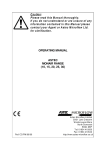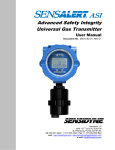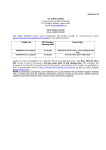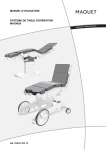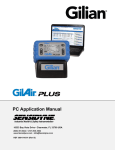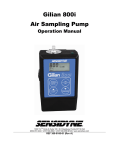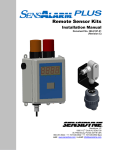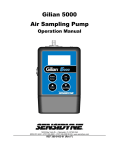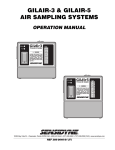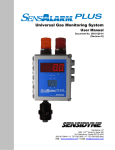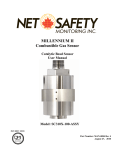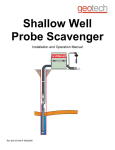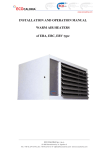Download SensAir Combustible Transmitter
Transcript
Combustible Gas Transmitter User Manual Document No. 360-0157-01 Rev C Sensidyne, LP • 1000 112th Circle N, Suite 100 St. Petersburg, Florida 33716 USA 800-451-9444 • +1 727-530-3602 • +1 727-539-0550 [fax] web: www.sensidyne.com • e-mail: [email protected] SensAir Combustible Gas Transmitter How to Use This Manual This manual is a basic guide for using the SensAir Combustible Transmitter. It contains information on the transmitter, transmitter components, and the Normal Operation Display. It also shows how to mount and wire the transmitter, initial setup, zeroing, and span calibration. In addition, it covers commonly used operations regarding alarms and relays. For reference, the entire menu structure is outlined in Appendix- Menu Map Because the SensAir Combustible Transmitter is menu driven, it is important to become familiar with how the magnetic switch controls are used to navigate through the menus, select specific menu items, and change the many different parameters available to the user. The Menu Map in the Appendix will help you toward this end. Sensidyne Document No. 360-0157-01 (Rev C) 3 SensAir Combustible Gas Transmitter Table of Contents How to Use This Manual ................................................................................................................................ 3 Packing List and Notices................................................................................................................................ 6 WARNINGS.................................................................................................................................................... 7 1 INTRODUCTION ........................................................................................................... 9 2 SENSAIR PART NUMBER SYSTEM.......................................................................... 10 3 COMPONENTS ........................................................................................................... 11 3.1 Condulet Housing ............................................................................................................................... 11 3.2 Display ................................................................................................................................................ 11 3.2.1 Electronics.................................................................................................................................. 11 3.3 4 The Sensor Assembly......................................................................................................................... 12 INSTALLATION .......................................................................................................... 13 4.1 Location .............................................................................................................................................. 13 4.2 Transmitter Installation (Enclosure) .................................................................................................... 13 4.3 Transmitter Location ........................................................................................................................... 14 4.3.1 Wiring ......................................................................................................................................... 14 4.3.1.1 4.3.2 4.3.3 5 Transmitter Wiring Diagram.................................................................................................................. 14 Allowable Line Length ................................................................................................................ 15 Wiring Procedure ....................................................................................................................... 15 OPERATION ............................................................................................................... 16 5.1 Output Current .................................................................................................................................... 16 5.2 Interferents.......................................................................................................................................... 16 5.2.1 Flooding ..................................................................................................................................... 16 5.2.2 Inhibition and Poisoning ............................................................................................................. 17 6 START UP PROCEDURE ........................................................................................... 18 7 CALIBRATION ............................................................................................................ 19 8 4 7.1 Equipment........................................................................................................................................... 19 7.2 Zeroing................................................................................................................................................ 19 7.3 Select Calibration Gas Concentration ................................................................................................ 19 7.4 Calibration Procedure ......................................................................................................................... 19 MAINTENANCE .......................................................................................................... 20 Sensidyne Document No. 360-0157-01 (Rev C) SensAir Combustible Gas Transmitter 8.1 9 Sensor Assembly Replacement ..........................................................................................................20 APPENDIX- MENU MAP ................................................................................................ 21 10 APPENDIX- FAULT CODES....................................................................................... 23 11 APPENDIX- DIMENSIONAL DRAWINGS .................................................................. 24 11.1 Standard, Horizontal Mounting ............................................................................................................24 11.2 Vertical Mounting .................................................................................................................................25 12 APPENDIX- CALIBRATION EQUIPMENT ................................................................. 26 Zero Calibration Gases...............................................................................................................................26 Calibration Gases .......................................................................................................................................26 13 APPENDIX – ACCESSORIES AND SPARES ............................................................ 27 14 APPENDIX- SPECIFICATIONS .................................................................................. 28 15 APPENDIX- SELECTIVITY FACTORS....................................................................... 30 16 APPENDIX- ALLOWABLE LINE LENGTHS .............................................................. 33 17 APPENDIX- TROUBLESHOOTING GUIDE................................................................ 34 18 RETURNED MATERIAL AUTHORIZATION...................................................................... 35 19 APPROVAL RATINGS ................................................................................................... 36 20 CONTROL DRAWINGS.................................................................................................. 37 Sensidyne Document No. 360-0157-01 (Rev C) 5 SensAir Combustible Gas Transmitter Packing List and Notices You should have the following items: SensAir Combustible Gas Transmitter unit Magnetic Screwdriver User Manual (this document) Always check to make certain you have received all of the items listed above. If you have any questions or need assistance, contact your Sensidyne Representative, or call 800-451-9444 or +1 727-530-3602 PROPRIETARY NOTICE This manual was prepared by Sensidyne, LP exclusively for the owner of the SensAir Combustible Gas Transmitter. The material within this manual is the proprietary information of Sensidyne, LP and is to be used only to understand and operate the instrument. By receiving this document, the recipient agrees that neither this document nor the information disclosed within nor any part shall be reproduced or transferred, physically, electronically or in any form or used or disclosed to others for manufacturing or for any other purpose except as specifically authorized in writing by Sensidyne, LP. COPYRIGHT NOTICE ©2012, Sensidyne, LP All rights reserved. Information contained in this document is protected by copyright. No part of this document may be photocopied, reproduced, or translated to another program or system without prior written authorization from Sensidyne, LP TRADEMARK NOTICE Sensidyne, the Sensidyne logo, SensAlert, the SensAlert & SensAir Combustible logos, T-O-D & Test-onDemand are registered trademarks of Sensidyne, LP. The trademarks and service marks of Sensidyne, LP are protected through use and registration in the United States of America. SOFTWARE LICENSE The software included with the SensAir Combustible Transmitter is the property of Sensidyne, LP and shall remain the property of Sensidyne, LP in perpetuity. The software is protected by U.S. and international copyright laws and is licensed for specific use with the SensAir Combustible Gas Transmitter. The user may not reverseengineer, disassemble, decompile, or make any attempt to discover the source code of the software. The software may not be translated, copied, merged or modified in any way. The user may not sublicense, rent, or lease any portion of the software. The right to use the software terminates automatically if any part of this license is violated. DISCLAIMER SENSIDYNE, LP ASSUMES NO RESPONSIBILITY WHATSOEVER, TO ANY PARTY WHOSOEVER, FOR ANY PROPERTY DAMAGE, PERSONAL INJURY, OR DEATH CAUSED BY OR RESULTING FROM, IN WHOLE, OR IN PART, THE IMPROPER USE, INSTALLATION, OR STORAGE OF THIS PRODUCT BY THE USER, PERSON, FIRM, ENTITY, CORPORATION OR PARTY NOT ADHERING TO THE INSTRUCTIONS AND WARNINGS OR NOT ADHERING TO ALL FEDERAL, STATE, AND LOCAL ENVIRONMENTAL AND OCCUPATIONAL HEALTH AND SAFETY LAWS AND REGULATIONS. THE SELLER SHALL NOT BE LIABLE FOR DIRECT, INDIRECT, CONSEQUENTIAL, INCIDENTAL OR OTHER DAMAGES RESULTING FROM THE SALE AND USE OF ANY GOODS AND SELLER’S LIABILITY HEREUNDER SHALL BE LIMITED TO REPAIR OR REPLACEMENT OF ANY GOODS FOUND DEFECTIVE. THIS WARRANTY IS IN LIEU OF ALL OTHER WARRANTIES, EXPRESSED OR IMPLIED, INCLUDING BUT NOT LIMITED TO THE IMPLIED WARRANTIES OF MERCHANTABILITY AND FITNESS FOR USE OR FOR A PARTICULAR PURPOSE WHICH ARE EXPRESSLY DISCLAIMED. 6 Sensidyne Document No. 360-0157-01 (Rev C) SensAir Combustible Gas Transmitter WARNINGS READ AND UNDERSTAND ALL WARNINGS BEFORE USE Read and understand ALL warnings before using this product. Failure to read, understand, and comply with ALL warnings could result in property damage, severe personal injury, or death. Product is calibrated prior to shipment, however, this product must be calibrated prior to initial use. Calibrate at regular intervals in accordance with the User Manual. Failure to calibrate in accordance with the instructions in this manual and at the specified intervals may result in the product not operating properly or malfunctioning. Read and understand ALL applicable federal, state, and local environmental health and safety laws and regulations, including OSHA. Ensure complete compliance with ALL applicable laws and regulations before and during use of this product. The user/installer must understand the Hazardous Area Protection Concepts and Area Classifications applicable to their operation. Metal conduit with a conduit seal within 18” of the condulet must be used to ensure that the installation is explosion-proof, UNDER NO CIRCUMSTANCES should this product be used except by qualified, trained, technically competent personnel and not until the warnings, User Manual, labels, and other literature accompanying this product have been read and understood. Failure to read and understand the User Manual may result in preventable severe personal injury or death. ALWAYS wash your hands thoroughly after handling, calibrating, or servicing this product. ALWAYS wear eye protection (such as safety goggles), face shield, chemical resistant gloves and chemical resistant clothing when handling chemicals, or calibration sources. DO NOT get chemicals, gases, fumes, or vapors in your eyes or on your skin, as they may cause severe burns to skin and eyes. If chemicals, gases, fumes, or vapors get in your eyes or on your skin, wash the affected area with copious amounts of water and call a physician immediately. ALWAYS avoid any contact of acids with your skin or eyes. Seek immediate medical attention for any contact with acids. ALWAYS calibrate in a well ventilated area. Adequate precautions should be taken to prevent the buildup of ANY calibration sources or vapors. Avoid breathing ANY calibration fumes or vapors as they may be hazardous to your health. ALWAYS dispose of chemicals and calibration sources in compliance with ALL applicable safety laws, regulations, and guidelines for proper disposal. Failure to do so may result in environmental damage, property damage, personal injury or death. ALWAYS close ALL containers of chemicals used with this product after use. ALWAYS ensure that any compressed calibration substance sources are empty prior to disposal, should they be used. ALWAYS use clean, dry, inert materials to contain and transfer substances used for calibration. DO NOT remove, cover, or alter any label or tag on this product, its accessories, or related products. DO NOT operate this product should it malfunction or require repair. Operation of a malfunctioning product, or a product requiring repair may result in serious personal injury or death. DO NOT attempt to repair or modify instrument, except as specified in the Operation & Service Manual. If repair is needed, contact the Sensidyne Service Dept. to arrange for a Returned Material Authorization (RMA) Returned Material Authorization Users should refer to MSDS and suppliers’ instructions for proper handling and safety instructions for any chemicals used with this equipment. Sensidyne Document No. 360-0157-01 (Rev C) 7 SensAir Combustible Gas Transmitter WARNINGS READ AND UNDERSTAND ALL WARNINGS BEFORE USE Use ONLY genuine SENSIDYNE® replacement parts when performing any maintenance procedures described in this manual. Failure to do so may seriously impair instrument performance and affect the Hazardous Area Certification. Repair or alteration of the product beyond the scope of these maintenance instructions, or by anyone other than an authorized SENSIDYNE® service technician, could cause the product to fail to perform as designed and persons who rely on this product for their safety could sustain severe personal injury or death. The SensAir Combustible Gas Transmitter is an ambient air monitoring device. Restricting the access of ambient air to the sensor may result in less than optimal monitoring performance. Caution: For safety reasons this equipment must be operated and serviced by qualified personnel only. Read and understand instruction manual completely before operating or servicing. Attention: Pour des raisons de securite, cet equipement doit etre utilise, entretenu et repare uniquement par un personnel qualifie. Etudier le manual d’instructions en entier avant d’utiliser, d’entretenir ou de reparer l’equipement. Prolonged exposure to excessively high concentrations of flammable gas may cause the sensor to produce erroneous readings. Always make use of a rainshield to protect against variations caused by environmental conditions. Perform tests only within the specified operating ranges. Sudden changes in pressure may cause temporary fluctuations in the sensor reading. For Class 1 Division installations: Do not install in atmospheres containing keytones, alcohols, esters and acidic atmospheres. Important Calibration Considerations: Unit calibration must be done at altitude. Verify concentration of calibration gas before making calibration adjustments. Concentration can be altered by: Deterioration of the concentration of compressed calibration gas sources during storage. Interaction of the calibration gas with materials used to contain and transfer the gas, as for example, absorption onto and permeation through certain plastics. Interaction of the calibration gas with materials and/or ambient contaminants, as for example, absorption into water. If further translation is required, please contact the Sensidyne EU Authorized Representative (see Back Cover for contact information). 8 Sensidyne Document No. 360-0157-01 (Rev C) SensAir Combustible Gas Transmitter 1 INTRODUCTION This manual provides specific information concerning the installation, operation, calibration, and maintenance of the SensAir Combustible Gas Transmitter. IMPORTANT: Owners of the Combustible Gas Transmitter must read this manual in its entirety in order to ensure proper operation of the transmitter. The SensAir Combustible Gas Transmitter is an explosion-proof, single-point device capable of detecting the presence of various substances, which are either flammable gases or produce flammable vapors. The transmitter detects each substance below its LEL (Lower Explosive Limit) before the concentration is great enough to create a potentially explosive atmosphere. The standard transmitter consists of a display board and a power supply board housed in an explosion proof condulet, and a stainless steel catalytic bead sensor specifically designed to detect combustible substances. A complete monitoring system consists of the transmitter and a separate read-out device & power supply capable of monitoring a 4-20 mA output and supplying 12-30 Vdc power. Product specifications are located in Appendix B. Different versions of the transmitter are available (see Part Number Table). The selection of the version best suited to an application depends upon the application requirement. A stainless steel sensor is for improved corrosion resistance in harsh ambient environments. The sensor assembly is poison resistant and suitable for use where substances can inhibit and poison the sensor are known to be present in low concentrations. The substances include: • Silicon-containing compounds, such as silicone oils and greases (e.g., HMDS) • Phosphorus-containing compounds, such as pesticides. • Sulfur-containing compounds, such as carbon disulfide and hydrogen sulfide • Halogen-containing compounds, such as fluoro- and chloro-carbons • Lead-containing compounds, such as anti-knock petroleum additives • Metal-containing hydride gases. Sensidyne Document No. 360-0157-01 (Rev C) 9 SensAir Combustible Gas Transmitter 2 SensAir Part Number System SensAir Combustible WITH DISPLAY 8 2 0 ‐ 0 □□ □ | ↓ Display 6 7 No‐Display ‐ | | | | | | | ↓ | | | | | ↓ | | | | | | | | | | | | | | | | | ↓ | | 1 Combustible, Class 1 Division 1 2 Combustible, Class I Division 2 0 Horizontal Configuration‐ standard 1 Vertical Configuration 0 10 | ↓ 1 Cal for Methane 2 Cal for Propane 3 Cal for specific K‐ factor. Must specify Standard □□ | | Sensidyne Document No. 360-0157-01 (Rev C) SensAir Combustible Gas Transmitter 3 Components 3.1 Condulet Housing The condulet housing is made of cast aluminum, which provides an explosion-proof weather-resistant barrier between the electronics module and the ambient environment. The condulet is explosion- proof to protect the electronics from damage due to an external explosion and to prevent any electrical malfunction of the electronics module from triggering an external explosion. The housing is available with a window for the display of the transmitter. An o-ring on the condulet seated between the condulet cover and the base provides water-tight protection for the internal electronic components. It allows the transmitter to be used outdoors during inclement weather conditions. 3.2 Display The transmitter with display has Program and Up and Down selector magnetic switches. These are controlled via the magnetic screwdriver provided with the unit. Information on operating the various controls is located in the Appendix Menu Map. The display shows the following: (1) Gas Concentration The gas concentration is displayed in large characters, units of measure are %LEL. (2) PROGRAM Control (Switch) The Program switch is used to enter the programming menu. The switch is also used to select/save a menu item. (3) ▲ and ▼ The ▲ and ▼ control arrows are used to scroll up or down a list of items. These controls are also used to increase or decrease a value (such as an alarm setpoint). Holding the wand near the control (switch) causes the displayed value to either increase or decrease automatically. (4) LEDs The transmitter display has LEDs that light up when there is an alarm or fault condition occurring. Also, when the magnetic wand is brought close to a magnetic switch the LED associated with that switch lights up, confirming that contact has been made between the wand and the switch. 3.2.1 Electronics The electronics inside the condulet consist of a display board and a power supply board. They are housed within the explosion-proof condulet, and converts the sensor response into a 4-20 mA current, linearly proportional to the concentration of the combustible gas present at the sensor. Sensidyne Document No. 360-0157-01 (Rev C) 11 SensAir Combustible Gas Transmitter 3.3 The Sensor Assembly CAUTION: DO NOT attempt to install the sensor assembly into any transmitter other than the designated SensAir Combustible Gas Transmitter. The sensor assembly consists of a catalytic bead in a stainless steel housing. Stainless steel is recommended for improved corrosion resistance in harsh ambient environments. The catalytic device detects a combustible substance before the concentration becomes potentially explosive. Ambient gas or vapor diffuses to the sensor where the catalyst causes it to oxidize even though the concentration is less than 100 %LEL. Heat produced by this reaction at the sensor is proportional to the concentration of the combustible substance. The heat produced is converted into an electrical signal which is monitored by the electronics. The sensor is capable of detecting combustible substances in the range 0-100 %LEL. WARNING: The sensor CANNOT be used to monitor for toxic hazards. Example Acetaldehyde has a 100 %LEL of 4 %v (by volume) which is equal to 40,000 ppm. Thus 100 %LEL is equivalent to 4 %v (40,000 ppm), and 1 %LEL is equivalent to 0.04 %v (400 ppm). Acetaldehyde is also toxic, having a Threshold Limit Value (TLV) of 100 ppm. However, since the minimum detectable concentration, 1 %LEL, is greater than the TLV, the sensor cannot be used to monitor for toxic hazardousness. The sensor can be inhibited and damaged if it is “flooded” by exposure to concentrations greater than 100 %LEL. Exposure to concentrations above 100%LEL causes an over-range indication followed by indication below 100 %LEL, due to loss of sensitivity even though a potentially explosive concentration of the combustible gas or vapor still exists. Therefore, should an over-range condition ever exist, always investigate carefully and thoroughly before entering the affected area. 12 Sensidyne Document No. 360-0157-01 (Rev C) SENSIDYNE® COMBUSTIBLE GAS TRANSMITTER SensAir Combustible Gas Transmitter 4 Installation 4.1 Location The Combustible Gas Transmitter is a local area monitor. It is imperative that the transmitter be located in an area where the greatest concentration of the target gas will be present in the shortest period of time after the occurrence of a leak or other increase in the concentration of the target gas in the atmosphere. Expert consultation may be necessary to determine the most strategic location for optimum monitoring. In all circumstances, the plant safety officer or other appropriate personnel should be consulted before installation. Site determination, at a minimum, must consider the following factors: • • • • • most probable location of a leak physical properties of the target gas air convection in the area due to ventilation or ambient conditions operational environment presence of interferent gases Ultimately, monitoring efficiency, and the degree of protection it affords, depends upon how carefully this survey is made. 4.2 Transmitter Installation (Enclosure) Refer to all local electrical codes to ensure compliance for proper mounting. The transmitter mounts to a wiring conduit via (19 mm) 3/4” female NPT at the condulet. Metal conduit (with a conduit seal within 18” of the condulet) must be used to ensure that the installation is explosion-proof. To achieve a measure of RFI/EMI immunity, the enclosure and conduit must be grounded and shielded cable must be used. The transmitter should be mounted with the sensor facing down to prevent moisture and debris from collecting on the sensor itself. 1) Get confirmation from the safety officer that the area is free of hazardous atmospheres. 2) Unscrew and remove the condulet cover. 3) Confirm that the input and output wires are without power and thred (thread) them through the opening of the condulet. 4) Hold the wires out of the way and screw the condulet firmly into the conduit. 5) Cap the wires and replace the condulet cover if you are not going to wire the transmitter at this time. NOTE Five full threads of engagement are required to maintain explosion-proof rating. Sensidyne Document No. 360-0157-01 (Rev C) 13 SensAir Combustible Gas Transmitter 4.3 Transmitter Location 4.3.1 Wiring Refer to all local electrical codes to ensure proper wiring compliance. The use of shielded wire is recommended. NOTE The power supply must have a power source return isolated from earth ground. Shielded cable is recommended with shield terminated to earth ground to ensure a measure of RFI/EMI immunity. If the metal conduit to which the transmitter is mounted is not earth grounded, the condulet must be earth grounded via the green wire. The following sections provide specific information necessary to wire the transmitter to a power supply. A wiring diagram is provided to aid in wiring the transmitter to a power supply. Three (3) wires are required to connect the transmitter to a Sensidyne controller, or a customer supplied 1230 Vdc power supply and read-out device. See Figure 4.3.1 for wiring. 4.3.1.1 Transmitter Wiring Diagram NOTE Installation and wiring must be in accordance with National Electrical Code. Temperature rating of cable wire insulation must be specified to be above 75 C (167 F). If cable runs through temperatures which exceed 75 C, it should be specified for that environment. Power 3-Wire Powered Unit V+ Red 4-20 Output 4-20 mA White Ground RTN Black FIGURE 4.3.1 TRANSMITTER WIRING 14 Sensidyne Document No. 360-0157-01 (Rev C) SensAir Combustible Gas Transmitter 4.3.2 Allowable Line Length The maximum distance between the power supply and the transmitter is known as the allowable line length. It is a function of the power supply voltage, loop resistance, and termination resistance. This in turn determines allowable loop resistance and wire size. The allowable line lengths for various wire sizes as well as the allowable loop resistance for various power supply voltages. The allowable voltage range for the power supply is 12-30 Vdc. 4.3.3 Wiring Procedure The transmitter terminals will not accept wire gauges larger than 14 AWG. In all cases, the connections must be clean, tight and protected from the weather. They must meet all required electrical codes. Wire the transmitter as follows: 1) Get confirmation from the safety officer, or appropriate personnel, that the area is safe. 2) Verify that the conduit and the transmitter are securely connected together. 3) Verify that the input and output wires are (without power). 4) Unscrew and remove the condulet cover. 5) Verify that the total resistance of the wiring does not exceed the allowable loop resistance 6) Attach and secure the power source return (negative lead) wire to the “RTN” Terminal (3) on the J1 connector. 7) Attach and secure the 4-20 mA output wire to the “4–20 mA” Terminal (2) on the J1 connector. 8) Attach and secure the positive lead wire to the “V+” Terminal (1) on the J1 connector. 9) Replace the condulet cover if not proceeding with start-up at this time. 10) Before applying power to the transmitter, verify that all connections are correct. 11) Go to Start-Up Section when you are ready to perform the start-up procedure. Sensidyne Document No. 360-0157-01 (Rev C) 15 SensAir Combustible Gas Transmitter 5 Operation NOTE: The transmitter must be calibrated after initial installation and before normal operation is possible. (See Calibration Section) Monthly calibration is recommended to ensure proper operation. NOTE: Catalytic Bead sensors do not “fail safe” therefore, monthly calibration is recommended. Under normal operating conditions, the transmitter responds to the presence of combustible gas by producing a 4-20 mA current that is linearly proportional to the concentration of combustible gas present at the sensor. 5.1 Output Current When calibrated, the relationship between the output current of the transmitter (in mA) and the concentration of the target gas is linear. Concentration is shown as a Percentage of Full Scale. Because the SensAir Combustible Gas Transmitter measures 0–100%LEL, 100 %LEL = 100% of Full Scale. The transmitter is designed to respond similarly to most combustible substances at their respective Lower Explosive Limit (LEL) concentrations, despite the fact that these combustible substances may differ greatly in their concentrations as measured in %v (percent by volume) or ppm (parts per million). For example, Methane becomes potentially explosive (100 %LEL) at a 5 %v (by volume) concentration, while nOctane becomes potentially explosive (100%LEL) at a 1 %v concentration. Despite the fact that the percent by volume concentrations of methane and n-octane are different, the response of the transmitter to equal %LEL concentrations of methane and n-octane is very similar. See Appendix for LEL characteristics and approximate selectivity factors for many common combustible substances 5.2 Interferents 5.2.1 Flooding Flooding occurs when there is exposure to flammable gas or vapor concentrations greater than 100 %LEL (regardless of the actual % by volume). The transmitter is not suitable for detection of combustible substances at any concentration greater than 100 %LEL. The catalytic device within the sensor assembly can be inhibited and damaged by exposure to such a large concentration. In the typical flooded response the appearance of an output current greater than 20 mA occurs (an over- range condition), followed closely by a decrease in the output current to values less than 20 mA. However, the following decrease in output current is NOT necessarily due to dissipation of the combustible substance. Following a flooded response – when the area is again safe – the transmitter must be re-calibrated in order to ensure that the sensor assembly has not been damaged. If calibration is not successful the catalytic device has been damaged and the sensor assembly must be replaced. WARNING: Should an overrange condition occur, followed very closely by an apparent decrease in the concentration level, investigate the area. Consult the Safety Officer and CAREFULLY and THOROUGHLY investigate before entering. A potentially explosive concentration of the combustible substance may still exist. 16 Sensidyne Document No. 360-0157-01 (Rev C) SensAir Combustible Gas Transmitter 5.2.2 Inhibition and Poisoning Inhibition and Poisoning occur when the combustible by-products from some compounds are deposited onto the catalytic device within the sensor assembly. These depositions will deactivate the sensor. The degree of deactivation may be either partial or complete and may be either reversible or irreversible depending upon the concentration and the duration of exposure to the interfering compound. The sensor assembly should never be exposed to any of the following substances known to inhibit and poison the catalytic device: • Silicon-containing compounds, such as silicone oils and greases • Phosphorous-containing compounds, such as pesticides • Sulfur-containing compounds, such as carbon disulfide and hydrogen sulfide • Halogen-containing compounds, such as fluoro- carbons and chlorocarbons • Lead-containing compounds, such as anti-knock petroleum additives • Metal-containing hydrides. • Hydrocarbon compounds that polymerize and carburize on heating, such as styrene. WARNING: Following exposure to a poisonous substance, the transmitter must be re-calibrated in order to assure that the sensor assembly has not been damaged. If calibration is not successful the catalytic device has been damaged and the sensor assembly must be replaced. Sensidyne Document No. 360-0157-01 (Rev C) 17 SensAir Combustible Gas Transmitter 6 Start Up Procedure It is necessary to perform the following start up procedure upon initial installation. Performance of the startup procedure is not ordinarily required at the time of routine periodic calibration. However, the startup procedure should be performed when any of the following occurs: • loss of power for an extended period time • upon sensor assembly replacement • following a flooded response WARNING: The safety officer must ensure that the area is safe before the condulet may be opened. 1) Unscrew and remove the condulet cover. 2) Make certain the transmitter has been wired properly. 3) Apply power to the transmitter. Observe that the Display has proper indications. If the Display does not have proper indication go to Appendix Troubleshooting Guide to determine the cause of the problem. CAUTION: Do not continue with the start-up procedure until this problem has been corrected. 4) Allow the transmitter to warm up for at least 15 minutes. 5) Replace the condulet cover. Allow the unit to stabilize for at least 1 hour before calibrating the transmitter The Combustible Gas Transmitter must be calibrated prior to initial use and at regular monthly intervals thereafter. In addition, the calibration procedure must be performed if any of the following conditions occur: 6) • loss of power for an extended period of time • transmitter is overranged or flooded • sensor assembly is replaced Failure to maintain this schedule could result in impaired system performance and/or erroneous readings. CAUTION: Catalytic Bead sensors do not “fail safe”. NOTE If calibration is being performed prior to initial use or after sensor replacement, the transmitter must be allowed to stabilize with power applied for 1 hour before attempting the calibration procedure. All Sensidyne gas detection equipment is functionally tested and calibrated with known zero and span gases before shipment to the customer. However, it is recommended that qualified personnel verify operation after initial installation using known zero and span gases. For further information, please consult the ISA Recommended Practices for gas detectors. NSTALLAION 18 Sensidyne Document No. 360-0157-01 (Rev C) SensAir Combustible Gas Transmitter 7 Calibration NOTE: The calibration procedure should be performed at ambient conditions including altitude, with special attention paid to the humidity and temperature requirements of the transmitter. Zeroing must be performed prior to Calibration. 7.1 Equipment Calibration Gas Sensidyne offers a full line of equipment for properly calibrating the SensAir Combustible Gas Transmitter. Calibration equipment available for the Combustible Gas Transmitter is described below. Refer to Appendix Parts List for ordering information, and for a complete listing of available calibration equipment and accessories. Each calibration gas cylinder is shipped with an MSDS sheet (a NIST traceable calibration certificate also is available upon request). Regulator 0.5LPM regulator is recommended. Calibration Cup 7.2 Zeroing Using the magnetic wand: Hold “Program” for 2 seconds ZrO will appear Hold “Program” for 2 seconds to select “Up” arrow LED will light. Zeroing of transmitter taking place After 60 seconds, “Up” arrow LED will go out signifying Zeroing is complete. 7.3 Select Calibration Gas Concentration Using the magnetic wand: Hold “Program” for 2 seconds ZrO will appear Hold “Down” until GAS appears Hold “Program” for 2 seconds to select Saved Calibration Gas Concentration will appear Use “Up” and “Down” to adjust the Calibration Gas Concentration if needed Hold “Program” for 2 seconds to save new gas concentration 7.4 Calibration Procedure Using the magnetic wand: Hold “Program” for 2 seconds ZrO will appear Hold “Down” for 1 second CAL will appear Hold “Program” for 2 seconds to select Down arrow LED will light (calibrating transmitter). To Escape calibration mode hold “UP” for 15 seconds Apply gas After 60 seconds of stable gas, “Down” arrow LED will go out and calibration is complete. Pass or Failure code will appear. Remove gas. Normal display will return after test gas dissipates. Sensidyne Document No. 360-0157-01 (Rev C) 19 SensAir Combustible Gas Transmitter 8 Maintenance The Sensidyne SensAir Combustible Gas Transmitter does not require any periodic maintenance unless a malfunction occurs. In the event of a malfunction, refer to Appendix Troubleshooting Guide. Use the Troubleshooting Guide to determine the cause of and remedy for common problems which may occur in the field. This section describes certain simple maintenance procedures that may be performed in the field. Field maintenance should be limited to: • Sensor assembly replacement The disposable sensor assembly should be replaced if it is damaged or when it no longer performs properly. 8.1 Sensor Assembly Replacement CAUTION: The transmitter is certified explosion-proof and is intended for use in areas which may contain potentially explosive substances. The safety officer must ensure that the area is safe before the condulet is opened. Remove power from the transmitter. Unscrew and remove the condulet cover. Disconnect the 3 colored wires from the sensor. Remove the rainshield if one is attached. Unscrew and remove the old sensor assembly from the lower opening of the condulet. Discard the old assembly. Thread the three colored wires from the new sensor assembly through the lower opening of the condulet. Apply sealant to the threads of the new sensor assembly housing to ensure a watertight seal and prevent seizing. Silicone based sealant must never be used on or near these sensors. Conductive pipe dope is recommended. Screw the new sensor assembly firmly into place. Connect and secure the white wire to “-Ve” Terminal (1) on the Sensor (J2) terminal strip. Connect and secure the yellow wire to the “SIG” Terminal (2) on the Sensor (J2) terminal strip. Connect and secure the pink wire to “+Ve” Terminal (3) on the Sensor (J2) terminal strip. Make certain all wiring is secure. Connect voltmeter to TP3 and TP4. Apply power to the transmitter. Through the AdJ menu adjust the sensor voltage to 2.000 volts DC. Replace and secure the condulet cover. Make certain the condulet o-ring is properly seated when tightening the condulet. 5 full threads are required to meet the XP rating. Allow the transmitter to warm up for at least 15 minutes. 20 Sensidyne Document No. 360-0157-01 (Rev C) SensAir Combustible Gas Transmitter 9 Appendix- Menu Map The setup and operation of the SensAir Combustible is controlled by parameters and procedures that are accessed through the menu structure. Menu Map 1. Transmitter Modes 1.1. Zeroing 1.1.1. Hold “Program” for 2 seconds. 1.1.2. ZrO will appear. 1.1.3. Hold “Program” for 2 seconds to select. 1.1.4. Up arrow LED will light (zeroing transmitter). 1.1.5. After 60 seconds Up arrow LED will go out (zeroing completed). 1.2. Calibration 1.2.1. Hold “Program” for 2 seconds. 1.2.2. ZrO will appear. 1.2.3. Hold “Down” for 1 second. 1.2.4. CAL will appear. 1.2.5. Hold “Program” for 2 seconds to select. 1.2.6. Down arrow LED will light (calibrating transmitter), if “Up” held for 15 seconds escape calibration mode. 1.2.7. Apply gas, if “Up” held for 15 seconds escape calibration mode. 1.2.8. After 60 seconds of stable gas Down arrow LED will go out (calibration completed). 1.2.9.Pass or Failure Code will appear. 1.2.10. Remove gas. 1.2.11. Normal display will return after test gas dissipates. 1.3. Calibration Gas Concentration 1.3.1. Hold “Program” for 2 seconds. 1.3.2. ZrO will appear. 1.3.3. Continue to hold “Down” until GAS appears. 1.3.4. Hold “Program” for 2 seconds to select. 1.3.5. Present calibration gas concentration will appear and High Alarm LED will light. 1.3.6. Using the Up / Down arrows the gas concentration will change once a second. 1.3.7. Hold “Program” for 2 seconds to save gas concentration, or no user action for 20 seconds and the gas concentration will revert to the previous value. 1.3.8. Unit will return to the normal screen. 1.4. Adjust K Factor 1.4.1. Hold “Program” for 2 seconds. 1.4.2. ZrO will appear. 1.4.3. Continue to hold “Down” until FCt appears. 1.4.4. Hold “Program” for 2 seconds to select. 1.4.5. Present K Factor will appear and High Alarm LED will light. 1.4.6. Using the Up / Down arrows the gas concentration will change once a second. The limits are 3.0 and 0.5. Sensidyne Document No. 360-0157-01 (Rev C) 21 SensAir Combustible Gas Transmitter 1.4.7. Hold “Program” for 2 seconds to save the K Factor, or no user action for 20 seconds and the K Factor will revert to the previous value. 1.4.8. Unit will return to the normal screen. 1.5. Hold Current Loop 1.5.1. Hold “Program” for 2 seconds. 1.5.2.ZrO will appear. 1.5.3.Continue to hold “Down until HOd appears. 1.5.4. Hold “Program” for 2 seconds to select. 1.6. Sensor Voltage Adjust 1.6.1. The sensor voltage must be adjusted anytime the sensor is replaced in the main transmitter. The voltage at the sensor must be maintained at 2.000 +/‐ 0.005 Volts DC. 1.6.2. If the sensor voltage is adjusted the sensor must be re‐zeroed and calibrated. 1.6.3.Hold “Program” for 2 seconds. 1.6.4. ZrO will appear. 1.6.5. Continue to hold “Down” until AdJ appears. 1.6.6. Hold “Program” for 2 seconds to select. 1.6.7. Three dashes will appear and High Alarm LED will light. 1.6.8. Using the Up / Down arrows the sensor voltage will change every 0.2 seconds. 1.6.9.Hold “Program” for 2 seconds to save the sensor voltage, or no user action for 20 seconds and the sensor voltage will revert to the previous value. 1.6.10. Unit will return to the normal screen. 1.7. Adjust 4 – 20 mA current loop 4 mA setpoint 1.7.1. Hold “Program” for 2 seconds. 1.7.2. ZrO will appear. 1.7.3. Continue to hold “Down” until A 4 appears. 1.7.4. Hold “Program” for 2 seconds to select. 1.7.5. Three dashes will appear and High Alarm LED will light. 1.7.6. Using the Up / Down arrows the 4 mA setpoint will change every 0.2 seconds. 1.7.7.Hold “Program” for 2 seconds to save the setpoint, or no user action for 20 seconds and the setpoint will revert to the previous value. 1.7.8. Unit will return to the normal screen. 1.8. Adjust 4 – 20 mA current loop 20 mA setpoint 1.8.1. Hold “Program” for 2 seconds. 1.8.2. ZrO will appear. 1.8.3. Continue to hold “Down” until A20 appears. 1.8.4. Hold “Program” for 2 seconds to select. 1.8.5. Three dashes will appear and High Alarm LED will light. 1.8.6. Using the Up / Down arrows the 20 mA setpoint will change every 0.2 seconds. 1.8.7.Hold “Program” for 2 seconds to save the setpoint, or no user action for 20 seconds and the setpoint will revert to the previous value. 22 Sensidyne Document No. 360-0157-01 (Rev C) SensAir Combustible Gas Transmitter 10 Appendix- Fault Codes F00 – Not Assigned F01 – Sensor Failed F02 – Cal Mode Calibration Fail, outside gain range F03 – Cal Mode Gas not present after 5 minutes, User aborted calibration F04 – Cal Mode Gas not stable after 5 minutes, User aborted calibration Sensidyne Document No. 360-0157-01 (Rev C) 23 SensAir Combustible Gas Transmitter 11 Appendix- Dimensional Drawings 11.1 Standard, Horizontal Mounting 24 Sensidyne Document No. 360-0157-01 (Rev C) SensAir Combustible Gas Transmitter 11.2 Vertical Mounting Sensidyne Document No. 360-0157-01 (Rev C) 25 SensAir Combustible Gas Transmitter 12 Appendix- Calibration Equipment Product Number 580-0001-01 7010032-1 821-0604-01 7016042 Description Regulator (0.5 LPM), for use with all gases PVC Carrying Case (holds two gas cylinders, plus regulator, tubing & fitting) Calibration Cup Tygon® Tubing, 3/16” ID x 5/16”, sold per foot Zero Calibration Gases Product Number 009824-15 009824-25 Description Zero Gas for Oxygen (O2) or Infrared sensors, 100% Nitrogen (103L) Zero Gas for all other sensors including Infrared, 20.9% O2 in N2 (103L) Calibration Gases All calibration gases are in Aluminum or Steel cylinders containing either 58 SL or 103 SL of gas. Gas is shipped with a Material Safety Data Sheet (MSDS). A NIST traceable calibration certificate is available upon request. Product Number Description 009824-68.................. Acetylene, C2H2, 1.25%vol / 50 %LEL in Air (103 SL) 009824-6.................... Hydrogen, H2, 2 %vol / 50 %LEL in Air ((103 SL) 009824-2.................... Methane, CH4, 1.5 %vol / 30 %LEL in Air (103 SL) 009824-3.................... Methane CH4, 2.5 %vol / 50 %LEL in Air (103 SL) 009824-72.................. Pentane, 0.75%vol. / 50% LEL (103 SL) 009824-61.................. Propane C3H8, 1.05%Vol / 50 %LEL in Air (103 SL) 26 Sensidyne Document No. 360-0157-01 (Rev C) SensAir Combustible Gas Transmitter 13 Appendix – Accessories and Spares Product Number 821-0603-01 821-0604-01 821-0605-01 214-0038-11 Description Sensor Shield Calibration Cup Flow Block Sensor Sensidyne Document No. 360-0157-01 (Rev C) 27 SensAir Combustible Gas Transmitter 14 Appendix- Specifications Sampling System ..................................... Diffusion Detection Range ..................................0–100 %LEL Housing .................................................... Aluminum condulet Weight ...................................................... 3.7lbs [1.7Kg] Electrical Specifications Power Requirement ................................. 24 Vdc, nominal, 125 mA Voltage ..................................................... 12-30 Volts DC Current Maximum..................................... 300mA, typical 125mA Termination Resistance ........................... < 500 (250 recommended) Grounding ................................................ Condulet must be earth grounded via conduit Transmission Link .................................... 4–20 mA current, non-isolated 3 wires Classification/Certification Explosion-Proof Rating ............................ NEC/CEC CL1, Div 1 & Div 2 Groups A, B, C, D, T4 ATEX II 2 G Ex d IIC T4 II 3 G Ex nA d IIC T4 Intrinsic Safety Rating .............................. Not intrinsically safe Sensor Specifications Minimum Detectable Concentration......... 1 %LEL Minimum Detectable Change Repeatability ............................................ 3% of Full Scale Accuracy .................................................. 10% of Indication or 5% of Full Scale, whichever is less Zero Drift .................................................. 1 %LEL methane/month Span Drift ................................................. < 1% of signal/month Response Time (Rise) ............................. T90 < 5 sec., T50 < 4 sec. Recovery Time (Fall)................................ T10 < 30 sec Operating Temperature Range ................ -20 to 75 C (-4 to 167 F) Storage Temperature Range ................... -40 to 50 C (-40 to 122 F) Operating Humidity Range....................... 0-95% RH, non-condensing Operating Pressure Range ...................... Nominal pressure effect due to variation of concentration ................................................................ resulting from compression or expansion with changing pressure Sensor Life (Expected)............................. Standard: 1 year, normal service Calibration Frequency .............................. Monthly (recommended) Calibration Concentration ........................ 30–80 %LEL of combustible substance Calibration Flowrate ................................. 0.5 LPM, recommended Oxygen Requirement ............................... 10% by volume, minimum 28 Sensidyne Document No. 360-0157-01 (Rev C) SensAir Combustible Gas Transmitter Special State Indication Indication is the 4 – 20 mA current loop at a value of 3 mA or below or a value of 21.6 mA or above User Adjustable Parameters Calibration Gas Concentration…………...10 to 100 %LEL K-factor…………………………………….. 0.5 to 3.0 Sensor Voltage Adjust……………………..1.8 to 3.0 Volts Current Loop 4 mA Setpoint…………….…1.0 to 6.8 mA Current Loop 20 mA Setpoint…………….. 12.0 to 26.0 mA Sensidyne Document No. 360-0157-01 (Rev C) 29 SensAir Combustible Gas Transmitter 15 Appendix- Selectivity Factors NOTE: SensAir has been performance tested using methane only therefore the instrument is intended for sensing methane specifically or intended to be use as a general purpose combustible gas detector when calibrated using methane. A —%LEL Concentration of Substance Equivalent to 1 %LEL Methane B —%LEL Concentration of Substance Equivalent to 30 %LEL Methane C —%LEL Concentration of Substance Equivalent to 50 %LEL Methane D —%LEL Concentration of Methane Equivalent to 30 %LEL Substance E —%LEL Concentration of Methane Equivalent to 50 %LEL Substance F —%Vol Concentration of Methane Equivalent to 30 %LEL Substance G —%Vol Concentration of Methane Equivalent to 50 %LEL Substance Molecular Weight Substance Methane A B C D E F G 5.0 1.0 30 50 30 50 1.50 2.50 44.0 4.0 1.7 51 85 18 29 0.88 1.47 16.0 Acetalaldehyde Acetic Acid %Vol @ 100 %LEL 60.0 4.0 1.9 57 95 16 26 0.79 1.32 102.1 2.7 2.2 66 110 14 23 0.68 1.14 Acetone 58.1 2.5 1.9 57 95 16 26 0.79 1.32 Acetylene 26.0 2.5 1.8 54 90 17 28 0.83 1.39 Acetic Anhydride Allyl Alcohol 8.1 2.5 2.0 60 100 15 25 0.75 1.25 17.0 15.0 0.8 24 40 38 63 1.88 3.13 8.2 1.1 3.0 90 150 10 17 0.50 0.83 Aniline 93.1 1.3 2.6 78 130 12 19 0.58 0.96 Benzene 78.1 1.3 2.4 72 120 13 21 0.63 1.04 Biphenyl 154.2 0.6 4.0 120 200 8 13 0.38 0.63 1,3-Butadiene 54.1 2.0 1.8 54 90 17 28 0.83 1.39 n-Butane 58.1 1.6 1.7 51 85 18 29 0.88 1.47 1-Butane 56.1 1.6 2.2 66 110 14 23 0.68 1.14 cis-2-Butane 56.1 1.7 2.1 63 105 14 24 0.71 1.19 trans-2-Butane 56.1 1.8 2.0 60 100 15 25 0.75 1.25 n-Butyl Alcohol 74.1 1.4 2.9 87 145 10 17 0.52 0.86 tert-Butyl Alcohol 74.1 2.4 1.4 42 70 21 36 1.07 1.79 n-Butyl Benzene 143.2 0.8 3.2 96 160 9 16 0.47 0.78 Ammonia n-Amyl Alcohol n-Butryic Acid 88.1 2.0 2.6 78 130 12 19 0.58 0.96 Carbon Monoxide 28.0 12.5 1.3 39 65 23 38 1.15 1.92 Cyanogen 52.0 6.6 1.1 33 55 27 45 1.36 2.27 Cyclohexane 84.2 1.3 2.4 72 120 13 21 0.63 1.04 Cyclopropane 42.1 2.4 1.6 48 80 19 31 0.94 1.56 142.3 0.8 3.0 90 150 10 17 0.50 0.83 73.1 1.8 2.0 60 100 15 25 0.75 1.25 n-Decane Diethylamine table continues on next page) 30 Sensidyne Document No. 360-0157-01 (Rev C) SensAir Combustible Gas Transmitter A —%LEL Concentration of Substance Equivalent to 1 %LEL Methane B —%LEL Concentration of Substance Equivalent to 30 %LEL Methane C —%LEL Concentration of Substance Equivalent to 50 %LEL Methane D —%LEL Concentration of Methane Equivalent to 30 %LEL Substance E —%LEL Concentration of Methane Equivalent to 50 %LEL Substance F —%Vol Concentration of Methane Equivalent to 30 %LEL Substance G —%Vol Concentration of Methane Equivalent to 50 %LEL Substance Molecular Weight %Vol @ 100 %LEL A B C D E F G 5.0 1.0 30 50 30 50 1.50 2.50 45.1 2.8 1.7 51 85 18 29 0.88 1.47 2,3-Dimethyl Pentane 100.2 1.1 2.5 75 125 12 20 0.60 1.00 2,2-Dimethyl Propane 72.2 1.4 2.5 75 125 12 20 0.60 1.00 1,4-Dioxane 88.1 2.0 2.2 66 110 14 23 0.68 1.14 Ethane 30.1 3.0 1.5 45 75 20 33 1.00 1.67 Substance Methane 16.0 Dimethylamine Ethyl Acetate 88.1 2.0 2.0 60 100 15 25 0.75 1.25 Ethyl Alcohol 46.1 3.3 1.4 42 70 21 36 1.07 1.79 Ethylamine 45.1 3.5 1.9 57 95 16 26 0.79 1.32 106.2 1.0 2.8 84 140 11 18 0.54 0.89 Ethylbenzene Ethylcyclopentane 98.2 1.1 2.5 75 125 12 20 0.60 1.00 Ethylene 28.1 2.7 1.4 42 70 21 36 1.07 1.79 Ethylene Oxide 44.0 3.0 1.9 57 95 16 26 0.79 1.32 Ethyl Ether 74.1 1.9 2.2 66 110 14 23 0.68 1.14 Ethyl Formate 74.1 2.8 2.3 69 115 13 22 0.65 1.09 n-Heptane 100.2 1.1 2.6 78 130 12 19 0.58 0.96 n-Hexane 101.2 1.1 2.7 81 135 11 19 0.56 0.93 Hydrazine 32.0 2.9 2.2 66 110 14 23 0.68 1.14 Hydrogen 2.0 4.0 1.3 39 65 23 38 1.15 1.92 Hydrogen Cyanide 27.0 5.6 2.1 63 105 14 24 0.71 1.19 Isobutane 58.1 1.8 1.9 57 95 16 26 0.79 1.32 Isobutyl Alcohol 74.1 1.7 1.9 57 95 16 26 0.79 1.32 Isobutyl Benzene 143.2 0.8 3.1 93 155 10 16 0.48 0.81 72.2 1.4 2.2 66 110 14 23 0.68 1.14 Isopentane Isopropyl Ether 102.2 1.4 2.3 69 115 13 22 0.65 1.09 Methyl Acetate 74.1 3.1 2.0 60 100 15 25 0.75 1.25 Methyl Alcohol 32.0 6.0 1.2 36 60 25 42 1.25 2.08 (table continues on next page) Sensidyne Document No. 360-0157-01 (Rev C) 31 SensAir Combustible Gas Transmitter A —%LEL Concentration of Substance Equivalent to 1 %LEL Methane B —%LEL Concentration of Substance Equivalent to 30 %LEL Methane C —%LEL Concentration of Substance Equivalent to 50 %LEL Methane D —%LEL Concentration of Methane Equivalent to 30 %LEL Substance E —%LEL Concentration of Methane Equivalent to 50 %LEL Substance F —%Vol Concentration of Methane Equivalent to 30 %LEL Substance G —%Vol Concentration of Methane Equivalent to 50 %LEL Substance Molecular %Vol @ Weight 100 %LEL A B C D Substance Methane 32 16.0 E F G 5.0 1.0 30 50 30 50 1.50 2.50 1.92 Methylamine 31.1 4.9 1.3 39 65 23 38 1.15 Methylcyclohexane 98.2 1.2 2.3 69 115 13 22 0.65 1.09 Methyl Ether 46.1 3.4 1.6 48 80 19 31 0.94 1.56 Methyl Ethyl Ether 60.1 2.0 2.3 69 115 13 22 0.65 1.09 Methyl Ethyl Ketone 72.1 1.4 2.4 72 120 13 21 0.63 1.04 Methyl Formate 60.0 4.5 1.5 45 75 20 33 1.00 1.67 Methyl Proprionate 88.1 2.5 2.0 60 100 15 25 0.75 1.25 Methyl Propyl Ketone 86.1 1.5 2.4 72 120 13 21 0.63 1.04 Napthalene 128.2 0.8 2.9 87 145 10 17 0.52 0.86 Nitromethane 61.0 7.3 13.7 411 685 2 4 0.11 0.18 n-Nonane 128.2 0.8 3.2 96 160 9 16 0.47 0.78 n-Octane 114.2 1.0 2.7 81 135 11 19 0.56 0.93 n-Pentane 72.2 1.5 2.2 66 110 14 23 0.68 1.14 Propane 44.1 2.1 1.8 54 90 17 28 0.83 1.39 n-Propyl Alcohol 60.1 2.2 2.1 63 105 14 24 0.71 1.19 n-Propylamine 59.1 2.0 2.1 63 105 14 24 0.71 1.19 Propylene 42.1 2.0 1.9 57 95 16 26 0.79 1.32 Propylene Oxide 58.1 2.3 2.2 66 110 14 23 0.68 1.14 Propyne 40.1 1.7 2.4 72 120 13 21 0.63 1.04 Toluene 92.2 1.2 2.5 75 125 12 20 0.60 1.00 Triethylamine 101.2 1.2 2.5 75 125 12 20 0.60 1.00 Trimehtylamine 59.1 2.0 2.1 63 105 14 24 0.71 1.19 Vinyl Ethyl Ether 72.1 1.7 2.4 72 120 13 21 0.63 1.04 m-Xylene 106.2 1.1 2.6 78 130 12 19 0.58 0.96 o-Xylene 106.2 1.0 2.8 84 140 11 18 0.54 0.89 p-Xylene 106.2 1.1 2.6 78 130 12 19 0.58 0.96 Sensidyne Document No. 360-0157-01 (Rev C) SensAir Combustible Gas Transmitter 16 Appendix- Allowable Line Lengths Power Supply Voltage (Vdc) 4-20mA Termination (Ohms) Allowable Loop Resistance (Ohms) 30 250 110 28 250 95 26 250 80 24 250 65 22 250 58 20 250 51 18 250 20 16 250 14 Sensidyne Document No. 360-0157-01 (Rev C) Wire Gauge 14 16 18 20 24 14 16 18 20 24 14 16 18 20 24 14 16 18 20 24 14 16 18 20 24 14 16 18 20 24 14 16 18 20 24 14 16 18 20 24 Allowable Line Length (Feet) 27,000 17,000 10,600 6,050 4,200 23,400 14,700 9,200 5,200 2,300 19,800 12,400 7,800 4,400 1,950 16,200 10,200 6,350 3,600 1,600 12,600 7,900 4,950 2,800 1,250 9,000 5,650 3,550 2,000 850 5,400 3,400 2,100 1,200 500 1,800 1,100 700 400 170 Allowable Line Length (Meters) 8,200 5,150 3,250 1,800 1,250 7,100 4,450 2,800 1,550 700 6,000 3,800 2,350 1,350 550 4,900 3,100 1,950 1,100 490 3,800 2,400 1,500 850 380 2,700 1,700 1,050 600 270 1,600 1,000 650 360 160 500 340 210 120 50 33 SensAir Combustible Gas Transmitter 17 Appendix- Troubleshooting Guide Problem . Unable to attain 4mA output current. Unable to attain output current corresponding to %LEL concentration. 34 Cause Remedy No power to the transmitter. Apply 12-30Vdc. Power input and 4-20mA output wires are reversed. Verify positive voltage at the power input. Power supply voltage is less than 12Vdc. Verify power supply voltage to be 1230Vdc. There is no connection between the power supply and the current output of the transmitter. Verify wiring. Sensor is incorrectly installed. Verify wiring. Power supply voltage is greater than 30Vdc. Verify power supply voltage to be 1230Vdc. Sensor assembly is defective. Disconnect sensor assembly. Measure the resistance between the colored wires. If resistance is between any pair of wires is <1ohm or >5ohms, replace sensor. Electronics board is defective. Replace electronics board. Current output of transmitter is shorted. Verify wiring. 4mA is misadjusted. Adjust the 4mA level. Electronics board is defective. Replace electronics board. Actual concentration of calibration substance is not the expected concentration. Verify the concentration of the calibration substance. Replace the calibration substance and/or assure proper delivery of the calibration substance to the sensor. Actual concentration of calibration substance is not the expected concentration. Verify that the outside of the sensor assembly is clean. Blow away any debris on the sensor assy with "zero grade" air if necessary. 4mA is misadjusted. Adjust the 4mA level. Sensor assembly is defective. Disconnect sensor assembly. Measure the resistance between the colored wires. If resistance is between any pair of wires is <1ohm or >5ohms, replace sensor. Electronics board is defective. Replace electronics board. Sensidyne Document No. 360-0157-01 (Rev C) SensAir Combustible Gas Transmitter 18 Returned Material Authorization Sensidyne maintains an instrument service facility at the factory to provide its customers with both warranty and non-warranty repair. Sensidyne assumes no liability for service performed by personnel other than authorized Sensidyne authorized personnel. To facilitate the repair process, please contact the Sensidyne Service Department in advance for assistance with a problem which cannot be remedied and/or requires the return of the product to the factory. All returned products require a Returned Material Authorization (RMA) number. Sensidyne Service Department personnel may be reached at: Sensidyne, LP 1000 112th Circle N, Suite 100 St. Petersburg, FL 33716 USA 800-451-9444 • +1 727-530-3602 +1 727-538-0671 [Service Fax] email: [email protected] All non-warranty repair orders will have a minimum fee assessed whether the repair is authorized or not. This fee includes handling, administration and technical expenses for inspecting the instrument and providing an estimate. However, the estimate fee is waived if the repair is authorized. If you wish to set a limit to the authorized repair cost, state a “not to exceed” figure on your purchase order. Please indicate if a price quotation is required before authorization of the repair cost, understanding that this invokes extra cost and handling delay. Sensidyne’s repair policy is to perform all needed repairs to restore the instrument to its full operating condition. Repairs are handled on a “first in - first out” basis. Your order may be expedited if you authorize an expediting fee. This will place your order next in line behind orders currently in process. Pack the instrument and its accessories (preferably in their original packing) and enclose your return address, purchase order, shipping and billing information, RMA number, a description of the problem encountered with your instrument and any special instructions. All prices are subject to change without notice. If this is the first time you are dealing directly with the factory, you will be asked to prepay or to authorize a COD shipment. Send the instrument, prepaid, to: SENSIDYNE 1000 112th Circle N, Suite 100 St. Petersburg, FL 33716 USA ATTENTION: Service Department RMA #:_______________________ SERVICE OPTIONS The Sensidyne Service Department offers a variety of service options which will minimize costly interruptions and maintenance costs. These options include initial training, on-site technical assistance, and full factory repairs. Sensidyne has developed several programs which offer options best suited to your applications and needs. For further information, contact the Sensidyne Service Department at the following numbers: 800-451-9444 • +1 727530-3602 • +1 727-538-0671 [Service Fax]. Sensidyne Document No. 360-0157-01 (Rev C) 35 19 Approval Ratings SensAir Cmb HD Div1 WARNING: Substitution of components may impair suitability for Division 1. WARNING: Do not open enclosure while circuits are live, or when combustible vapors may be present. CAUTION: Read and understand instruction manual before operating or servicing. Install in accordance with Control Drawing Number 099-2014-01. NEC/CEC CL I, DIV 1, GPS A, B, C, D, T4 FM6320, C22.1 No. 152. Not including ketones, alcohols, esters and acidic atmospheres. CE 0518 II 2 G Ex d IIC T4 Ta = -20C to +75C FM13ATEX0066 Input Ratings: 12-30VDC 500mA 6W SensAir Cmb HD Div2 WARNING: Substitution of components may impair suitability for Division 2. WARNING: Do not open enclosure while circuits are live, or when combustible vapors may be present. CAUTION: Read and understand instruction manual before operating or servicing. Install in accordance with Control Drawing Number 099-2014-02. NEC/CEC CL I, DIV 2, GPS A, B, C, D, T4 FM6320, C22.1 No. 152. Not including ketones, alcohols, esters and acidic atmospheres. II 3 G Ex nA d IIC T4 Gc Ta = -20C to +75C FM13ATEX0084 Input Ratings: 12-30VDC 500mA 6W 36 Sensidyne Document No. 360-0157-01 (Rev C) Sensidyne Document No. 360-0157-01 (Rev C) +V 4-20 mA RTN CONTROL EQUIPMENT NOTES: 1. INSTALLATION IN THE U.S. SHOULD BE IN ACCORDANCE WITH THE NATIONAL ELECTRICAL CODE (ANSI/NFPA 70) SECTIONS 501 THRU 505. 2. INSTALLATION IN CANADA SHOULD BE IN ACCORDANCE WITH THE CANADIAN ELECTRICAL CODE, CSA C22.1, PART 1, APPENDIX F. 3. INSTALLATION IN EUROPE MUST COMPLY WITH THE REQUIREMENTS OF EN 60079-14. 4. INSTALL PER THE APPROPRIATE DIVISION WIRING METHOD. 5. APPROPRIATELY RATED SEALS ARE REQUIRED DURING INSTALLATION. +V 4-20 mA RTN CONTROL EQUIPMENT NONHAZARDOUS LOCATION SEE NOTE 5 Ta = -20 C to +75C ONLY DECLASSIFIED AREA 02/28/2013 4 B 1 1 099-2014-01 SENSAIR TRANSMITTER CERT CONTROL INSTALLATION REQUIREMENTS FM13ATEX0066 DO NOT CHANGE WITHOUT THE APPROVAL OF FM W.THOMPSON LIVE MAINTENANCE: II 2 G Ex d IIC T4 EUROPEAN APPROVAL RATINGS: NEC/CEC CL I, DIV 1, GPS A, B, C, D, FM6320, C22.1 No. 152, Not including ketones, alcohols, esters and acidic atmospheres. U.S. AND CANADIAN APPROVAL RATINGS: HAZARDOUS (CLASSIFIED) LOCATION - (NEC-CEC) DIVISION 1; (EUROPE) ZONE 1 SEE NOTE 5 20 Control Drawings • Control Drawing Number 099-2014-01 37 38 +V 4-20 mA RTN +V 4-20 mA RTN NOTES: 1. INSTALLATION IN THE U.S. SHOULD BE IN ACCORDANCE WITH THE NATIONAL ELECTRICAL CODE (ANSI/NFPA 70) SECTIONS 501 THRU 505. 2. INSTALLATION IN CANADA SHOULD BE IN ACCORDANCE WITH THE CANADIAN ELECTRICAL CODE, CSA C22.1, PART 1, APPENDIX F. 3. INSTALLATION IN EUROPE MUST COMPLY WITH THE REQUIREMENTS OF EN 60079-14. 4. INSTALL PER THE APPROPRIATE DIVISION WIRING METHOD. 5. APPROPRIATELY RATED SEALS ARE REQUIRED DURING INSTALLATION. CONTROL EQUIPMENT CONTROL EQUIPMENT NONHAZARDOUS LOCATION SEE NOTE 5 W.THOMPSON 02/28/2013 5 B 1 1 099-2014-02 SENSAIR TRANSMITTER CERT CONTROL INSTALLATION REQUIREMENTS FM13ATEX0084 DO NOT CHANGE WITHOUT THE APPROVAL OF FM ONLY DECLASSIFIED AREA LIVE MAINTENANCE: II 3 G Ex nA d IIC T4 Gc Ta = -20C to +75C EUROPEAN APPROVAL RATINGS: NEC/CEC CL I, DIV 2, GPS A, B, C, D, FM6320, C22.1 No. 152, Not including ketones, alcohols, esters and acidic atmospheres. U.S. AND CANADIAN APPROVAL RATINGS: HAZARDOUS (CLASSIFIED) LOCATION - (NEC-CEC) DIVISION 2; (EUROPE) ZONE 2 SEE NOTE 5 • Control Drawing Number 099-2014-02 Sensidyne Document No. 360-0157-01 (Rev C) Notes Notes Manufactured by: Sensidyne, LP 1000 112th Circle N, Suite 100 St. Petersburg, Florida 33716 USA 800-451-9444 • 727-530-3602 • 727-539-0550 [fax] www.Sensidyne.com • [email protected] Authorized EU Representative Schauenburg Electronic Technologies GmbH Weseler Str. 35 · 45478 Mülheim-Ruhr Germany +49 (0) 208 9 99 10 • +49 (0) 208 5 41 10 [fax] www.schauenburg.com • [email protected] Sensidyne, LP • 1000 112th Circle N, Suite 100 St. Petersburg, Florida 33716 USA 800-451-9444 • +1 727-530-3602 • +1 727-539-0550 [fax] web: www.sensidyne.com • e-mail: [email protected]










































